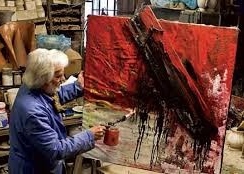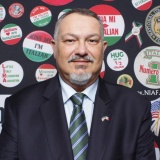
WTI Magazine #71 2015 October, 30
Author : Giulia Carletti Translation by:
A sincere attachment to primordial earth and its prime materials is what pervades the variegated œuvre of the Italian artist Gastone Primon. Gastone Primon started his career as a ceramist in Este, his hometown, yet today he lives and works in the south of Rome. Throughout the years he has being shaping himself as a polyhedral artist, being him a painter and a sculptor. During the first years of the 1960s, Primon attended important exhibitions and art fairs around the world (Italy, Spain, Germany, Australia) in which he began to affirm himself as an internationally relevant artist.
Primon's œuvre crosses through a variety of media. From bronze to clay, from ceramic to sand, his works explore uncommon techniques and various materials. Baking, oxidizing, glazing, melting and burning are his favorite techniques, for they allow painting to become sculpture and sculpture to become painting.
His work reveals a predilection for craftsmanship and manual work, as Primon is concerned with such concepts as transformation (both physical and metaphorical) and human creation. Accordingly, the famous ceramist Nino Caruso describes him as constantly experimenting the ever-changing faces of matter. Tellingly, Primon's paintings have a deep materic quality, for poor materials replace the paint tubes. They do not follow the mere "color/form" dichotomy, but rather explore assemblage and collage techniques: wooden crates, pressed cardboards, wrapped plastic – painted and burnt – are all elements that he uses. Such practices do not come from painting, but from ceramic work, which he grew up with in Este (city famous for its traditional ceramics).
A recurrent feature in Primon's work is the personal dialogue with natural objects and phenomena. He has a predilection for wood and stone, especially if previously processed by nature. On one of his painting, a piece of wood previously struck by lightning is attached to the red-painted canvas. Often Primon relies on elements and objects found in nature, especially when consumed by a story or altered by time. That renders such objects lived and alive: worth of being included into a work of art.
To such interesting techniques an as well interesting concept corresponds. The natural and the archaic are indeed recurrent themes in Primon, who often works with archeological findings and fossil records, along with products and waste of modern industrial society. Nonetheless, more than a mere critique to modern world, Primon's art is a loud recall to those cultures living in an archaic yet dynamic harmony with nature. During his sojourn in Jordan – from 1987 to 1990 (during which he taught arts and crafts at the Design Handcraft Training Center in Salt) – he was able to taste those Mediterranean cultures as found as before the conquest of the Western ratio, and frequent are the references to myth. The warm and sandy colors of the adjacent Syria as well as its ancient yet alive culture deeply inspired his art.
In this respect, one may describe his art as a sterile rehashing of Arte Povera (poor art), the 1960s Italian artistic movement, which – through its exaltation of poor materials and reference to the Italian rural roots – gave birth to an alternative history of art that challenged the coeval American conceptualism. That is why, nowadays, Primon risks being hidden by the smokes of the great wings of Arte Povera and Informale, like Mertz, Pistoletto, Burri, and Penone. However, even if he surely owes something to such an eloquent artistic movement, Primon's contributes to art should not be underestimated. A personal optimism and a thoughtful confidence in the matter – as eternal genetrix of life – determine his art. Primon's spherical creations for example (like Sphere A and The Big Sphere) are a fervent celebration to life. They are fossils, relicts of an ancient pre-human world, asteroids bringer life, images of unknown yet alive planets. Birth, life, death, and a feeling of regeneration of a metamorphic nature replace the decadent content of Arte Povera.
Through such original techniques and courageous juxtaposition of different materials, Primon understands his works as the ultimate heroic act: that of human creation. Through the act of transforming, new beings come to light, and this makes us consider man as a sapient result of the multiple and mutual transformations of matter.



